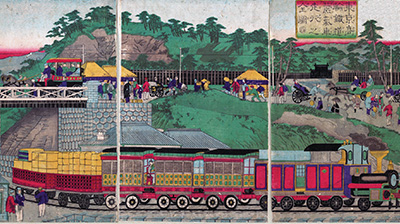Industrialization
Teacher Resources
Driving Question: How did industrialization transform societies around the world?
The political revolutions of the long nineteenth century weren’t the only sort of upheaval people experienced in this period. The long nineteenth century also witnessed the Industrial Revolution. New technologies transformed every facet of industrialized societies. People responded to these changes in many ways, resisting, adapting, and working for reform.
Learning Objectives:
- Understand the origins and effects of the Industrial Revolution.
- Use the course frames to evaluate the different impacts of industrialization.
- Create arguments using historical evidence to support claims and communicate conclusions through informal writing.
Vocab Terms:
- abolition
- consumer
- fossil fuel
- Industrial Revolution
- industrialization
- innovation
- textile
Opener: Industrialization
To teach this lesson step, refer to page 2 of the Lesson 5.1 Teaching Guide.
Our Openers and Closers Guide will provide more information about these short, but important, activities at the beginning and end of each lesson.
Good sources don’t have to be long, boring texts. Music can show us a different side of history and open a lyrical window to the past.
Looking Ahead
To teach this lesson step, refer to page 3 of the Lesson 5.1 Teaching Guide.
Our Writing Guide shares our approach to informal and formal writing, including Unit Notebooks.
Agree or disagree? Evaluate some statements before you dive into Unit 5—then see how accurate you were when you get to the end of the unit.
Industrialization
To teach this lesson step, refer to page 3 of the Lesson 5.1 Teaching Guide.
Looking for tips on using video in an instructionally sound way? Look no further than the OER Project Video Guide.
The Industrial Revolution rapidly changed all aspects of human societies, from how we produced goods to the shape of our families. This video and article will introduce you to the causes and effects of industrialization.
-
Guiding Questions
-
Before you watch
Preview the questions below, and then review the transcript.
While you watch
Look for answers to these questions:
- How did people produce goods immediately prior to the Industrial Revolution?
- What big change led to the foundation of industrialization?
- How did industrialization change our sense of community?
- What happened to exports, labor, and CO₂ emissions when states industrialized?
- What made Britain’s rapid industrialization possible? What evidence does the video use?
After you watch
Respond to this question: Do you think industrialization was a good thing for a society during this period?
Key Ideas
-
Guiding Questions
-
Before you read
Preview the questions below, and then skim the article. Be sure to look at the section headings and any images.
While you read
Look for answers to these questions:
- What are some of the elements of modern life that didn’t exist prior to 1750?
- What are some reasons for Britain’s early industrialization?
- Take a look at the photo of the 2012 Olympics. Why do you think Britain would want to celebrate being the birthplace of industrialization?
- What are some ways that the impacts of industrialization varied for different people and places?
- How did the Industrial Revolution change families?
After you read
Respond to this question: Do you think the Industrial Revolution was more significant than the political revolutions of the long nineteenth century?
Framing Unit 5
To teach this lesson step, refer to page 5 of the Lesson 5.1 Teaching Guide.
The OER Project Community forum is a great resource for helping students grasp the concept of frames—check out the discussion!
The Industrial Revolution changed how people made goods, but it also forever changed the shape of our communities and the speed and intensity of our connections.
-
Guiding Questions
-
Before you watch
Preview the questions below, and then review the transcript.
While you watch
Look for answers to these questions:
- What did preindustrial production and distribution look like?
- Why did industrialized societies have an advantage over nonindustrialized societies?
- How did the movement of people away from villages and into industrial cities lead to new types of communities?
- What were conditions like in many factories?
- How did the conditions in factories lead to the development of new networks?
After you watch
Respond to the following question: Why do you think international networks were so important to the work of reformers in this period?
Key Ideas
Closer: Industrialization
To teach this lesson step, refer to page 7 of the Lesson 5.1 Teaching Guide.
This discussion in the OER Project Community forum highlights the hexagonal thinking strategy.
How are the big ideas of industrialization connected? Explore the interconnected and far-reaching impacts of the Industrial Revolution.
Reviewing for Claim and Focus
To teach this lesson step, refer to page 7 of the Lesson 5.1 Teaching Guide.
By suggesting revisions to someone else’s writing, you’ll get much better at identifying what makes strong writing. Make suggestions for improving claim and focus—and then keep those suggestions in mind the next time you write.






